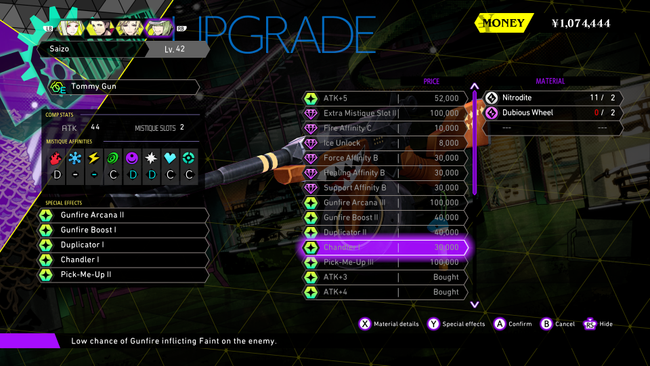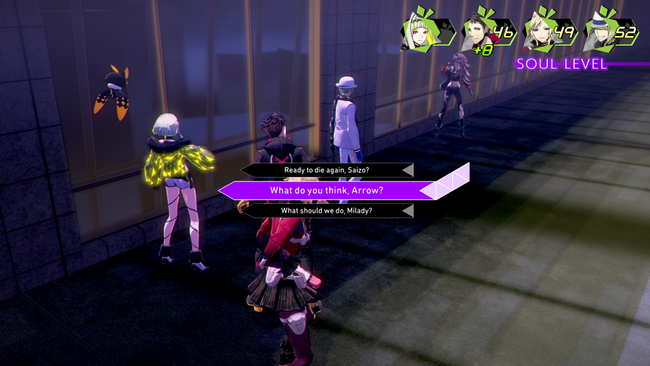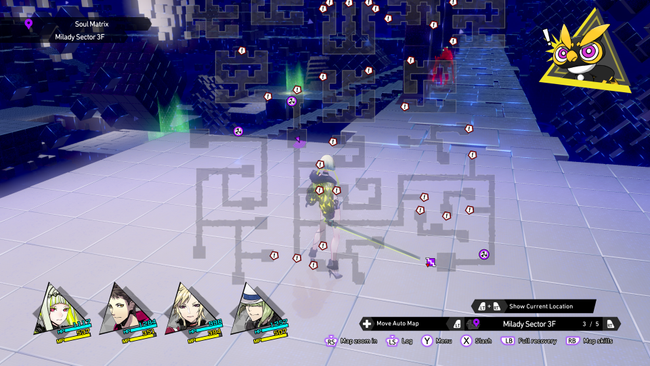
Soul Hackers 2 Review
In a way, Souls Hackers 2 is a game I've been waiting for from Atlus for a while now. As fond as I am of mainline Shin Megami Tensei and Persona titles, I've always held a special affinity for the various Megaten spinoff entries - especially in the PS2 era with titles like Digital Devil Saga or the Raidou Kuzunoha duology. With the shift to HD development, these sorts of spinoffs became more sparse, with a few mostly opting to head to Nintendo's handheld systems. The original Soul Hackers even received its first official English localization with a port for the 3DS, nearly a decade ago.
As the release of Soul Hackers 2 approaches, I personally see a lot of excitement for it, along with some uncertainty about what the game might be like. With Atlus RPGs often exhibiting an appreciable array of various styles and game focuses, I suspect the expectations placed on Soul Hackers 2 are also varied, depending on what any given player might be specifically looking for in an RPG. So, I think it's worth describing in detail what Soul Hackers 2 is actually like and what it is not.
This may be obvious, but it's worth stating anyway. Soul Hackers 2 is not a Persona game. It's not quite a proper Shin Megami Tensei title either. Ultimately, Soul Hackers 2 can draw some parallels from many inspirations in Atlus' library.

Soul Hackers 2 doesn't dwell long in its opening moments. Within the game's first hour or so, you are introduced to your permanent playable cast of Ringo, Arrow, Saizo, & Milady (pronounced mill-luh-dee), you learn the game's story premise of halting the resurrection of the so-called "Great One" by collecting 5 macguffins known as Covenants, and you are suddenly thrown into your first dungeon-trek.
This probably shouldn't be too much of a surprise if you've played the original Soul Hackers, but Soul Hackers 2 places quite a lot of focus on dungeon-crawling. It's not in first-person like its predecessor, but more often than not throughout the course of the game, you'll be within one of the game's dungeon layouts, battling enemies and powering up your characters. While you'll see a fair amount of story-focused scenes & character interaction, it's the dungeon crawling & combat that take up the majority of Soul Hacker 2's runtime. The game's default camera angle places you right up against the back of Ringo (perhaps uncomfortably so), and it works to at least somewhat emulate that forward-facing dungeon-crawler feel - just not in first-person.
For some bookkeeping, it's worth noting that I played an early PC version of Soul Hackers 2, which included various options to pull back the camera a bit and play the game more like a typical third-person RPG. PlayStation and Xbox versions will have this functionality added in a day one patch. Even if you decide to alter the camera at the first opportunity as I did, I think its default position is somewhat telling about the type of game Soul Hackers 2 was envisioned to be.

Soul Hackers 2 did not leave me with a great first impression at all. After an understandably unremarkable tutorial dungeon and being quickly introduced to the game's central cast, I was suddenly thrown into the Soul Matrix, a sort of persistent side dungeon that'll you'll revisit several times over the course of the game, with more floors unlocked periodically as you progress through the main narrative. Let's just say the dungeon design here early on, both aesthetically & functionally, was simply boring. Large swaths of these areas amounted to linear paths with a few dead ends - so straightforward as to be mundane.
The opening gameplay flow to Soul Hackers 2 is somewhat strange in general, opting to throw players into a sterile, lifeless, and lengthy side-dungeon so soon before the main thrust of the game has really even begun. Even so, the game's first 'proper' dungeon afterward isn't much better, sadly, mostly sticking to linear paths and simple encounters. For as much time as the game was placing me in these areas, everything felt plodding and monotonous. And don't get me wrong, I adore dungeon crawlers in general! Just not when the dungeons are so dull.
In fact, it took roughly 10 to 15 hours for Soul Hackers 2 to finally begin to grow on me, at least a little bit. It wasn't until the game's subway dungeon that I actually felt like there was *something* to see in the Soul Hacker 2's core gameplay facets, and even then I wish the dungeon design and combat components were more engaging than they were turning out to be in that moment. In any case, the early hours of Soul Hackers 2 are a dreary slow burn, mechanically.
If the dungeon design itself wasn't compelling, perhaps the combat could keep things interesting, but this too starts off with something of a whimper.

Combat in Soul Hackers 2 is a turn-based affair, but it isn't quite Shin Megami Tensei's "Press Turn" or Persona's "Once More". There are no extra turns to be gained or lost by hitting weaknesses or resistances. Instead, hitting an elemental weakness will increment a counter known as a Stack. At the end of every combat round, Ringo will perform a "Sabbath", where all the Stacked demons will deal a wave of damage to the enemy group - with a higher Stack count dealing more damage. This feels most similar to Strange Journey's Demon Co-op more than anything else.
Each character of your combat party can equip one demon at a time. You can kind of think of it like the older Persona titles here, where any character can be outfitted with any demon of your choosing. You can even change demons on the fly in battle, with some restrictions. While the demons themselves don't appear on the battlefield, the equipped demon will dictate what abilities that character can use, as well as that character's elemental defenses.
So, even though you don't need to manage and optimize extra turns this time around as you would in most Megaten titles, there is still a bit of flexibility and strategizing that does come into play in terms of optimizing your lineup as you progress through Soul Hackers 2. Generally speaking, obviously, you want to make sure you have most of your elemental attacks covered, as well as some healing and buff/debuff capabilities.
The standard difficulty in Soul Hackers 2 is more than manageable, where following basic strategic tenets will get you through just fine most of the time. In fact, if you are a veteran of these sorts of games, I suggest giving the Hard Mode option a try to really bring the most out of the game's combat encounters. Luckily you can change at any time, so you aren't stuck with any one option here. It's also worth noting that, even if Ringo falls in battle, you can still continue fighting - there's no classic "SMT Game Over" here in that case.
I come away somewhat ambivalent about Soul Hackers 2's combat, but I do appreciate the attempt to mix things up just a bit from a more typical Megaten-style battle system. Some of the best encounters in the game are the ones you can take on in optional quests, which often may require more specified strategies to come away victorious. Combat does get more and more compelling as you get deeper into the game, fortunately, but I felt it never reached the heights that Megaten games have been shown to be capable of.

The primary way you power up your characters in Soul Hackers 2 - other than by fusing higher-level demons with better abilities - is through the COMP Smith. Here is where the game takes its strongest inspiration from Tokyo Mirage Sessions, by frequently turning in monster drop items to improve the capabilities of a character - only this time through their COMP instead of a Carnage. There is also a related "Mistique" system in place, which can alter a character's capabilities through what is effectively a glorified accessory slot.
To get into all the minute details of Soul Hacker 2's COMP and Mistique system would probably be more wordy than necessary, but what it boils down to is that each character's capabilities improve over the course of the game, and not every character has identical utility. While any character can equip any demon, it turns out that certain characters are *slightly* better suited for certain types of attacks. Milady is the character best suited for dealing Fire-based damage, and Saizo is technically the best healer & support character, for example.
There are a few other places where Soul Hackers 2 changes things up from the usual formula. For example, demons can be recruited to your party, but not through the usual Demon Negotiation mechanics you often see in other Megaten titles. When you meet a demon in battle, you will not have the opportunity to talk to them for any reason. Instead, Soul Hackers 2 uses something called Demon Recon.
Demon Recon is honestly very simple. In each dungeon of the game, you can chat with demons from your stock at places alongside the dungeon path. Where they show up is semi-random, but they either give you an item, money, healing, or a chance to recruit a demon. If you give the demon what they want, they'll join you straight afterward.
I'm of two minds of this mechanic. Once you enter a negotiation, you don't need to worry about RNG, demon personalities, or the demon just leaving for no reason. As long as you give them what they want, they'll join, every time. The problem is that because demon recruitment is limited to semi-random Demon Recon spawns and not just from any battle, your actual number of opportunities to recruit a demon is far smaller. So in short, while demons are easier to convince to join you, actually finding the opportunity to convince them in the first place can be a bit tedious. In fact, I often felt using the Demon Compendium and fusion was often an easier way to get a demon I wanted - moreso than hoping I would find it in a Demon Recon.

Soul Hackers 2 does have a character affinity system, but it is much, much more streamlined than what you would find in a Persona Social Link. You, the player, never actually need to decide how to spend time or who to spend time with. Instead, you'll raise Ringo's affinity with Arrow, Milady, or Saizo in one of two ways.
First, you'll be given some dialogue choices through the game's main narrative that can raise a certain character's 'Soul Level' affinity. These choices have no bearing on the storyline of the game, and they will explicitly show you which character will receive an affinity boost. Second, as you progress through the game, you'll unlock 'Hangout Events', which are essentially little side conversations among the characters that will also boost their Soul Level.
These Soul Level-related story events and Hangout events all happen at pre-determined moments throughout the game. As you raise your Soul Level, you'll unlock further floors in that character's Soul Matrix dungeon. Besides its introduction and one other instance, the Soul Matrix is mostly an extensive optional dungeon that offers a little bit of backstory information on the cast of characters, as well as unlocks some new abilities for them to use.
If you were to quantify it within the context of the game, roughly half the content in Soul Hackers 2, if not more, is found in the Soul Matrix. If you are the type of player to generally not skip content, you'll be spending a lot of time here. The later floors of the Soul Matrix do eventually become more interesting than the early ones, for sure, in terms of dungeon design. You'll get your warp puzzles and slightly more labyrinthian mazes. They never reach the heights of some other Atlus dungeons, but they at least become respectable by the end of things.
As far as the characters themselves go, I found them to be largely serviceable, but not much more than that. With the cast being adults in a franchise usually saddled with teenagers, they do tend to deal with different sorts of personal struggles than other protagonists in the broader series. Ringo herself is a very rare speaking Megaten protagonist, and being effectively an AI construct herself, she'll spend a fair bit of time learning about humanity, emotions, and so on. She doesn't gain affinity with the other characters to try and romance them. It's more about understanding them as individuals, with distinct personalities and motivations. It's interesting conceptually, even if the execution is merely adequate.
The main storyline itself also comes across as a bit threadbare. There are no plotholes, egregiously poor writing, or anything like that. Much like other components of Soul Hackers 2, the storytelling is just a bit thin in general, ultimately coming across as somewhat hackneyed and done-before. It's difficult to say more than that without spoiling much, but I'll reiterate that Soul Hackers 2 plainly seems to put more emphasis on dungeons and battling.

Soul Hackers 2 feels similar to Atlus' PS2 era of Megaten titles, for better and for worse. It's a bit more experimental in various ways, and its scope is more focused, though a bit limited. This does result in the game sometimes feeling 'cheap', with many rigidly awkward model animations, frequently reused environmental assets, and limited voice acting. The English voicework overall is also only just serviceable, and despite usually being fond of Atlus English-dubbed voices, I personally think it's probably best to go with the Japanese voice cast this time around. In any case, Soul Hackers 2's restricted development scope feels evident, and I think the mechanics and concepts it places on display aren't quite enough to make up for it. At least the music by Monaca is great.
That said, I'm still glad that Atlus decided to publish a game like Soul Hackers 2, focusing more on a particular vision despite limitations rather than a massively polished mega-game aiming for broad appeal.
As an obligatory final note, the PC port of Soul Hackers 2 was largely fine during my playthrough, though with a couple of weird behavioral quirks. The game never seemed to open on the proper monitor of my multi-monitor setup, and sometimes it would struggle to actually close the game when I asked it to. There was also the occasional stutter in battle sequences, although it was hard to tell if it was due to the port itself or if it was simply inherent to the game. Otherwise, coming from Shin Megami Tensei V on Nintendo Switch, it was admittedly nice to see clean character models and environments without significant aliasing while running at 60+ fps framerates.
Depending on your perspective, Soul Hackers 2 can be seen as a happy medium between dungeon crawler, RPG, and social simulation. Or it can be seen as being in a sort of no man's land, where it incorporates elements of each while not quite excelling at anything. I come away feeling more toward the latter here, where no singular element of the game really managed to excite me beyond base satisfaction. Soul Hackers 2 is an adequate, experimental Megaten entry with some bright spots, but it doesn't quite all come together as well as I hoped it would.